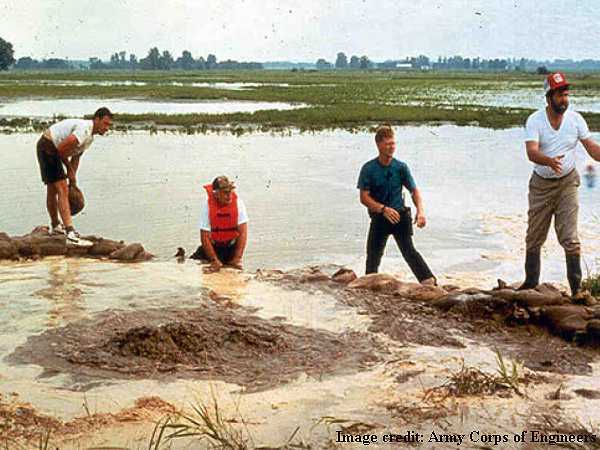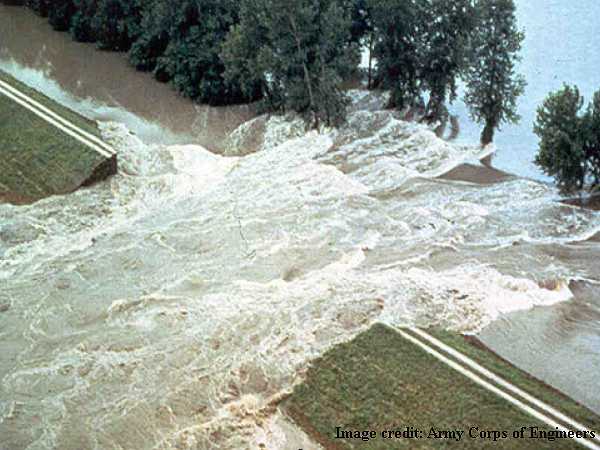LARGE ANIMAL RESCUE SKULL SESSION
|
| THE LEVEE IS GIVING WAY! |
|
Background.
In many river delta regions, the lands alongside rivers and sloughs are protected by levees. Many of these levees are ten or more feet in height. Over time, particularly with river flows regulated by dams, the river bottoms have silted to the point that in some places the river bottoms themselves are higher than the surrounding ground. During extreme rains or rapid snow melt, these levees can be taxed with water often reaching the levee tops. The levees are then typically reinforced with plastic tarps and sandbags. When we hear of flooding in these situations we think of water overtopping the levees and eroding channels through them. In reality the most sinister cause of failure, and one rescuers must be cautious about when working near stressed levees, is a boil. A boil starts with a trickle of water that appears in the ground on the "dry land" side of the levee. The water could be coursing through an old animal tunnel, where a rotten root traveled or by some other fracture of the compacted earth. A boil resembles a small volcano of water and boiling sand as the water erodes an even larger underground pathway until the volume of water passing under the levee reaches a point that the levee catastrophically fails.

To prevent a levee failure, a sandbag ring has to be placed completely around the boil, with the sandbags being stacked as high as necessary to prevent water from seeping through and pulling more sediment with it. The wall of the ring has to be thick enough so as not to fail itself once the ring fills with water. However if the ring holds, water should no longer be rapidly passing through the boil and the erosion of the levee should stop. However if the ring cannot be built in time or it fails, a catastrophic levee failure is likely to follow.

The actual incident. The San Joaquin River is within inches of overtopping the levees. About an hour and a half before sunset you have been advised by a nearby island fire department that a significant boil has been discovered near a levee that volunteers are struggling to control. There are several horse ranches within a short distance from the boil. People are evacuating since the only way in or out requires driving past the boil. Assistance is needed to remove up to 50 head of livestock, primarily horses. Roughly a dozen privately owned horse and stock trailers are available on an area callout sheet. They range from straight load trailers to modest sized gooseneck trailers. The trailer owners have varying degrees of horse experience. Few have any actual emergency training or experience. A large animal veterinarian who lives on the island is responding. You have put the County Fairgrounds (approximately 45 minutes away) on stand-by. One of the uninvolved fire departments has a auxiliary communications unit (staffed by trained public safety and amateur radio volunteers) available to you with an approximate ETA of one hour. You have the ability to communicate with the island fire department and with the auxiliary communications unit. Some of the horse owners have secured their animals inside their barns or in nearby corrals. A few horses owned by others have been left out in large pastures. One of the facilities is a breeding facility with mares and foals. You are advised that one of the mares with a foal is functionally blind. By the time the team is mustered to the rendezvous point, you have about an hour left before sunset. You have enough time to load for one trip to the fairgrounds before dark. Skull Session Questions
Please post your answers to the Technical Large Animal Emergency Rescue group. Skull Session rules. Please post your answers independently of the answers posted by others. Please also recognize that there can be varying perceptions as to what these scenarios involve since these problems are being solved using limited information. The values of these sessions include the various approaches the participants may suggest based on their varying perceptions of the problem, so it's not a matter of someone being right and someone being wrong. Please read, think, and post your answers to the TLAER Facebook group based on your perception of the problem presented. Continue to How the Incident was ResolvedGo to Skull Session IndexReturn to the Strike Team LRTC Page |
This material is intended for the use of the Technical Large Animal Emergency Rescue (TLAER) Facebook Group. TLAER is a trademark of Technical Large Animal Emergency Rescue. |